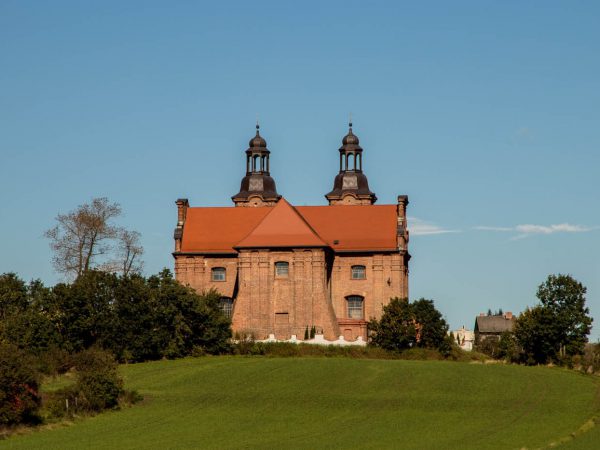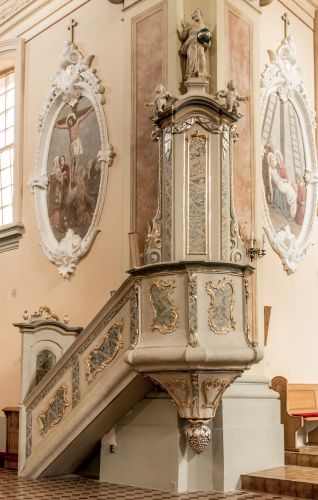
LĄDEK: church of St. Nicholas
Date of construction: 1760-1777Monuments
Christ who suffers
Wooden historical artworks as elements of furnishings are also found in churches made of stone. A beautiful processional cross attracts attention in the church of St. Nicholas in Lądek.
The sculpture which presents the dramatic moment of Christ’s death was created 500 years ago. Unknown artist focused on the details of the crucified body. The hands which carry the body’s weight are very stretched: muscles and tendons are depicted in great detail. Maybe by referring to the viewers’ imagination, the artist wanted to emphasize Christ’s suffering? He poured his own emotions into the sculpture by devoting himself to hard work with chisel and wood.
The figure of Christ, which has been saved form oblivion recently, is today a part of the processing cross that accompanies the citizens of Lądek during many ceremonies, eg. it leads Resurrection and Corpus Christi processions.
The acronym INRI put of the cross means: Iesus Nazarenus Rex Iudaeorum – Jesus of Nazareth Jewish King.
Christ’s tunic (so called perizonium) was presented in different ways during ages. In the Middle Ages, it was very short, draped with a knot on the side. .

A twin set
In the span between the chancel and the nave twin objects were put next to each other – a pulpit and a baptismal font. Made in the second half of the 18th century, they represent the Rococo style and are adorned with subtle rocaille (subtle ornaments in a shape of a shell or sea flora) with blue marbleization (a kind of painting on wood, a form of delicate venation which imitates marble, adding nobility).


The two objects were decorated with a backrest crowned with pelmets (decorated with a wooden curtain covered with silver). Above it there are figures: of John the Baptist on the baptismal font and Christ giving blessings on the pulpit, and canopies of both objects were topped with a beautiful silver bunch of grapes. Special attention should be put to the font which stands out by a closed canopy where a basin with holy water was placed. It is an extremely rare solution. Its form imitates the shape of the pulpit and only during the baptism ceremony does it reveals its purpose.
The legend of St. Nicolas

One of the most common patron saints of churches is St. Nicolas – we can find his image also on a feretory (a portable religious painting painted on both sides, in decorative frames which is held during processions) from Lądek. The oldest record of St. Nicolas says that he lived in the turn of the 3rd and 4th centuries and that he was a bishop of Myra. He became famous for his miracles and help for the poor. His parents were noble, rich and religious. When he grew up, he renounced women, entertainments, politics and trade and he devoted himself to piety.
St. Nicolas is thought to be the saint who helps in every need – that’s why so many churches are dedicated to him.
After his parents death Nicolas gave his money away. He advocated for victims, and aided the poor. He is presented with three marbles which can be attributed to a legend of the three neighbour’s daughters. The neighbour was punished by God for his greed and he lost his wealth so he didn’t have a dowry for the daughters. He wanted to sell them to a brothel. Then St. Nicolas decided to save the girls and he threw bags with money through windows. Only when the third daughter collected the money, did the neighbour decide to learn who was so generous and when he discovered the truth, ashamed he thanked Nicolas.
Confessio means ‘I confess’
Another element of the furnishings is not associated with a work of art. A confessional (from Latin confessio – ‘I confess’) is an object designed for a private confession. A confessional is a mute witness of confessions which men make for God; it witnesses humility, confessions of guilt, the need for the remission of sins and hope. The form in which priest listens to the faithful ensures anonymity of the sinner. Man who decides to take confession has to be sure that their sins will not get out of the wooden confessional through which they confide their weaknesses to God in hope of redemption.


